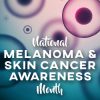According to the American Cancer Society, skin cancer and melanoma affect more people in the U.S. than any other form of cancer. Nearly 3.3 million Americans receive a skin cancer diagnosis every year. The Skin Cancer Foundation noted that seniors are at an increased risk of developing it. It’s crucial to know about these diseases to protect your health. Read on for more information:

What is healthy senior skin?
As you’ve grown older, you’ve likely noticed that your skin has changed. This largest organ of the body has likely become drier and flakier, and doesn’t heal as quickly as it did when you were younger. The National Institute of Health explains that skin thins out and loses fat content as a person ages. That is why you can likely see your veins and feel your bones more easily than you could a few years ago. You may have age spots, and even experience some itching, because your skin isn’t as naturally soft and smooth anymore. Many seniors experience dry spots that feel rough and may flake. If this sounds familiar, try using a daily moisturizer and drink more water.
Over the years, it’s typical to sweat less and produce a decreased amount of natural skin oil, so providing outside sources of moisture is key to keeping your skin supple and soft. Seniors also often find they bruise easily. Since your dermis is thinner than it has been in the past, it’s easier for something as seemingly innocuous as bumping into a table to turn into a large purple bruise. Your blood vessels aren’t as protected by multiple layers of fat and tissue. Unfortunately, this can increase your likelihood of developing skin cancer.
Types of skin cancer
There are three main types of skin cancer. Basal and squamous cell skin cancers begin in the outer layer of the skin. They tend to occur on areas of the body that are the most exposed to the sun, such as the hands, face, ears and neck. Squamous cancers are not especially common as they develop in the deeper layers of the skin and spread from there. Basal cell cancer is typically slow-growing and stays in one spot instead of metastasizing. Both of these types of the disease can be cured if they are treated before spreading.
The least common form of skin cancer is called melanoma. This disease starts in a melanocyte, a.k.a. skin cells that contain brown skin pigment. When undamaged, this type of the dermis protects the skin’s deep layers from being damaged by the sun. Melanomas do not necessarily occur in places of the body that are exposed to the sun. While they may develop on the face or hands, for example, they can also be found in the eyes, inside the mouth or on the genitals. Melanoma is easily curable if it is caught right away, but it can quickly grow to other parts of the body and become hard to treat. This type of skin cancer is the most deadly, and can cause over 10,000 of the 13,650 skin cancer-related deaths in a year, according to the ACS.
If you found an error, highlight it and press Shift + Enter or click here to inform us.



